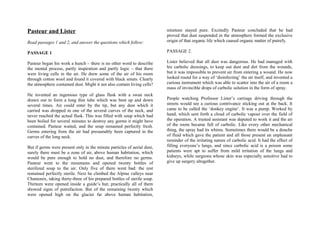
Pasteur and lister
- 1. Pasteur and Lister Read passages 1 and 2, and answer the questions which follow: PASSAGE 1 Pasteur began his work a hunch – there is no other word to describe the mental process, partly inspiration and partly logic – that there were living cells in the air. He drew some of the air of his room through cotton wool and found it covered with black smuts. Clearly the atmosphere contained dust. Might it not also contain living cells? He invented an ingenious type of glass flask with a swan neck drawn out to form a long thin tube which was bent up and down several times. Air could enter by the tip, but any dust which it carried was dropped in one of the several curves of the neck, and never reached the actual flask. This was filled with soup which had been boiled for several minutes to destroy any germs it might have contained. Pasteur waited, and the soup remained perfectly fresh. Germs entering from the air had presumably been captured in the curves of the long neck. But if germs were present only in the minute particles of aerial dust, surely there must be a zone of air, above human habitation, which would be pure enough to hold no dust, and therefore no germs. Pasteur went to the mountains and opened twenty bottles of sterilized soup to the air. Only five of them went bad: the rest remained perfectly sterile. Next he climbed the Alpine valleys near Chamonix, taking thirty-three of his prepared bottles of sterile soup. Thirteen were opened inside a guide’s hut; practically all of them showed signs of putrefaction. But of the remaining twenty which were opened high on the glacier far above human habitation, nineteen stayed pure. Excitedly Pasteur concluded that he had proved that dust suspended in the atmosphere formed the exclusive origin of that organic life which caused organic matter of putrefy. PASSAGE 2. Lister believed that all dust was dangerous. He had managed with his carbolic dressings, to keep out dust and dirt from the wounds, but it was impossible to prevent air from entering a wound. He now looked round for a way of ‘disinfecting’ the air itself, and invented a curious instrument which was able to scatter into the air of a room a mass of invincible drops of carbolic solution in the form of spray. People watching Professor Lister’s carriage driving through the streets would see a curious contrivance sticking out at the back. It came to be called the ‘donkey engine’. It was a pump. Worked by hand, which sent forth a cloud of carbolic vapour over the field of the operation. A trusted assistant was deputed to work it and the air of the room became full of carbolic. Like every other mechanical thing, the spray had its whims. Sometimes there would be a douche of fluid which gave the patient and all those present an unpleasant reminder of the irritating nature of carbolic acid. It had the effect of filling everyone’s lungs, and since carbolic acid is a poison some patients were apt to suffer from mild irritation of the lungs and kidneys, while surgeons whose skin was especially sensitive had to give up surgery altogether.
- 2. QUESTIONS a. From passage 1 describe, in not more than 60 words the two ways in which Pasteur proved that living germs cells came from the air. b. From passage 2 state, in not more than 30 words, the disadvantages of Lister’s spray. c. From passage 1 and 2 trace the connection between the work of Pasteur and the work of Lister. d. From passage 1 say why you think that the bottles of soup opened in the guide’s hut went bad. e. For each of the following words (all taken from passage 2) compose a sentence (i.e. four sentences in all) of not fewer than ten words, in which the word is used unchanged in form but with an entirely different meaning from its meaning in the passage: i. wound ii. solution iii.form iv. present f. Give the meaning of each of the following as used in the passages. (In the case of single words, both one-word answer and short phrases will be acceptable.) From passage 1: i. ingenious ii. minute iii. sterile iv. exclusive origin From passage 2: i. the field of the operation ii. deputed iii. whims iv. douche (From a specimen paper of the Local Examination Syndicate, University of Cambridge.)
